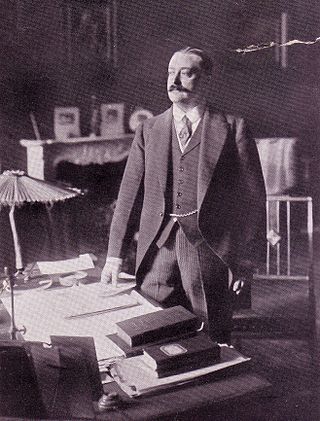
Austria-Hungary, also referred to as the Austro-Hungarian Empire or the Dual Monarchy, was a multi-national constitutional monarchy in Central Europe between 1867 and 1918. A military and diplomatic alliance, it consisted of two sovereign states with a single monarch who was titled both Emperor of Austria and King of Hungary. Austria-Hungary constituted the last phase in the constitutional evolution of the Habsburg monarchy: it was formed with the Austro-Hungarian Compromise of 1867 in the aftermath of the Austro-Prussian War and was dissolved shortly after Hungary terminated the union with Austria on 31 October 1918.

Leopold Anton Johann Sigismund Josef Korsinus Ferdinand Graf Berchtold von und zu Ungarschitz, Frättling und Püllütz was an Austro-Hungarian politician, diplomat and statesman who served as Imperial Foreign Minister at the outbreak of World War I.

The Austro-Hungarian Army, also known as the Imperial and Royal Army, was the principal ground force of Austria-Hungary from 1867 to 1918. It consisted of three organisations: the Common Army, the Imperial-Royal Landwehr and the Royal Hungarian Honvéd.

Ottokar Theobald Otto Maria Graf Czernin von und zu Chudenitz was an Austro-Hungarian diplomat and politician during the time of World War I, notably serving as Foreign Minister from 1916 to 1918.

Count László Szőgyény-Marich de Magyar-Szőgyén et Szolgaegyháza was an Austro-Hungarian diplomat of Hungarian origin who was a long serving Ambassador at Berlin.

The Ministry of Foreign Affairs is the government ministry of Austria responsible for diplomatic missions and immigration, the administration of foreign policy, and the maintenance of the country's relations with international organisations, especially the European Union. It oversees the Austrian embassies, consular representatives and other emissaries, and administers the naturalisation process and handles citizenship questions along with the Interior Ministry.

The Imperial and Royal Minister of War, until 1911: Reich Minister of War, was the head of one of the three common ministries shared by the two states which made up the dual monarchy of Austria-Hungary from its creation in the Compromise of 1867 until its dissolution in 1918.

Count Frigyes Szapáry de Szapár, Muraszombat et Széchy-Sziget, was an Austro-Hungarian diplomat of Hungarian origin serving as ambassador to St. Petersburg at the outbreak of World War I and who played a key role during the July Crisis of 1914.

Ludwig Alexander Georg Graf von Hoyos, Freiherr zu Stichsenstein was an Austro-Hungarian diplomat who played a major role during the July Crisis while serving as chef de cabinet of the Foreign Minister at the outbreak of World War I in 1914. He was the last chef de cabinet of Austria-Hungary. He was the grandson of Robert Whitehead, the inventor of the torpedo.

Nikolaus (Anton) Graf Szécsen von Temerin, was an Austro-Hungarian diplomat of Hungarian origin serving as ambassador at Paris at the outbreak of World War I.

Kajetan Mérey von Kapos-Mére, was an Austro-Hungarian diplomat of Hungarian origin serving as ambassador at Rome at the outbreak of World War I.
Count János Forgách de Ghymes et Gács, was an Austro-Hungarian diplomat of Hungarian origin who played a prominent role during World War I and in particular the July Crisis.
Ladislaus Freiherr Müller von Szentgyörgy was an Austro-Hungarian diplomat of Hungarian origin serving as ambassador at Tokyo at the outbreak of World War I.
The Austro-Hungarian Foreign Service was the diplomatic service carrying out the foreign policy of the Emperor of the Austro-Hungarian Empire from the formation of the Dual Monarchy in 1867 until it was dissolved in 1918.

The Federal Chancellery of Austria is the ministry led by the chancellor of Austria. Since the establishment of the First Austrian Republic in 1918, the Chancellery building has served as the venue for the sessions of the Austrian cabinet. It is located on the Ballhausplatz in the centre of Vienna, vis-à-vis the Hofburg Imperial Palace. Like Downing Street, Quai d'Orsay or – formerly – Wilhelmstrasse, the address has become a synecdoche for governmental power.
Count Miksa Hadik de Futak (1868–1921) was a Hungarian diplomat, who served as Austro-Hungarian Ambassador to Mexico from 1909 to 1911 and to Sweden from 1912 to 1918, until end of the First World War.

The Common Army as it was officially designated by the Imperial and Royal Military Administration, was the largest part of the Austro-Hungarian land forces from 1867 to 1914, the other two elements being the Imperial-Royal Landwehr and the Royal Hungarian Honvéd. However, it was simply known as the Army (Heer) by the Emperor and in peacetime laws, and, after 1918, colloquially called the k.u.k. Armee.

The Supreme Commander of the Imperial and Royal Armed Forces was the ultimate authority of the Austro-Hungarian Armed Forces – which comprised the Army, Navy and Aviation Troops of Austria-Hungary.

The Vienna Conference of March 16, 1917 was the first German-Austro-Hungarian meeting since the outbreak of the February Revolution in Russia. For Reich Chancellor Theobald von Bethmann Hollweg, the ministerial meeting was a further opportunity to reaffirm the Reich's war aims in the face of the dual monarchy's new Foreign Minister, Ottokar Czernin. Czernin, the minister of an empire in dire straits, tries to assert the point of view of the dual monarchy, exhausted by two and a half years of conflict, in the face of the Reich, the main driving force behind the quadruplice, and its demands for a compromise peace with the Allies. This decrepitude led Emperor Charles I and his advisors to multiply their initiatives to get out of the conflict, without breaking the alliance with the Reich.














